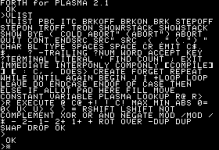resman
Veteran Member
There are probably more FORTH programmers here than PLASMA programmers (perhaps not really saying much), but I spent the Holiday break to implement a minimal FORTH in PLASMA. Although I've spent a lot of time in the lower level plumbing of FORTH, I never used it or really programmed in it. So I'm looking for feedback on the implementation I've come up with for the PLASMA environment. I put together a poor video as an introduction and a quick description of its unique features.
You can find the video here: https://youtu.be/picPyXAk77I
Quick overview here:https://github.com/dsch.../PLASMA/blob/master/doc/PLFORTH.md
And a floppy disk image to play at home here: https://github.com/.../blob/master/images/apple/PLFORTH.PO
If you have no idea what PLASMA is, you can satisfy your curiosity here: https://github.com/dschmenk/PLASMA
You can find the video here: https://youtu.be/picPyXAk77I
Quick overview here:https://github.com/dsch.../PLASMA/blob/master/doc/PLFORTH.md
And a floppy disk image to play at home here: https://github.com/.../blob/master/images/apple/PLFORTH.PO
If you have no idea what PLASMA is, you can satisfy your curiosity here: https://github.com/dschmenk/PLASMA

